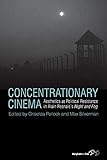Concentrationary Cinema : Aesthetics as Political Resistance in Alain Resnais's ‹I›Night and Fog‹/I› / ed. by Max Silverman, Griselda Pollock.
Material type: TextPublisher: New York ; Oxford : Berghahn Books, [2012]Copyright date: ©2012Description: 1 online resource (358 p.)Content type:
TextPublisher: New York ; Oxford : Berghahn Books, [2012]Copyright date: ©2012Description: 1 online resource (358 p.)Content type: - 9781782384984
- 9780857453525
- 791.43/658405318 23/eng/20230216
- D804.3.N853 C66 2011
- online - DeGruyter
| Item type | Current library | Call number | URL | Status | Notes | Barcode | |
|---|---|---|---|---|---|---|---|
 eBook
eBook
|
Biblioteca "Angelicum" Pont. Univ. S.Tommaso d'Aquino Nuvola online | online - DeGruyter (Browse shelf(Opens below)) | Online access | Not for loan (Accesso limitato) | Accesso per gli utenti autorizzati / Access for authorized users | (dgr)9780857453525 |
Frontmatter -- Contents -- List of Plates from Night and Fog -- List of Figures -- Foreword -- Acknowledgements -- Introduction: Concentrationary Cinema -- 1. Night and Fog: A History of Gazes -- 2. Memory of the Camps: The Rescue of an Abandoned Film -- 3. Opening the Camps, Closing the Eyes: Image, History, Readability -- 4. Resnais and the Dead -- 5. Night and Fog and the Concentrationary Gaze -- 6. Auschwitz as Allegory in Night and Fog -- 7. Night and Fog and Posttraumatic Cinema -- 8. Fearful Imagination: Night and Fog and Concentrationary Memory -- 9. Disruptive Histories: Towards a Radical Politics of Remembrance in Alain Resnais’s Night and Fog -- 10. Cinema as a Slaughterbench of History: Night and Fog -- 11. Death in the Image: The Responsibility of Aesthetics in Night and Fog (1955) and Kapò (1959) -- Bibliography -- Notes on Contributors -- Index
restricted access online access with authorization star
http://purl.org/coar/access_right/c_16ec
Since its completion in 1955, Alain Resnais’s Night and Fog (Nuit et Brouillard) has been considered one of the most important films to confront the catastrophe and atrocities of the Nazi era. But was it a film about the Holocaust that failed to recognize the racist genocide? Or was the film not about the Holocaust as we know it today but a political and aesthetic response to what David Rousset, the French political prisoner from Buchenwald, identified on his return in 1945 as the ‘concentrationary universe’ which, now actualized, might release its totalitarian plague any time and anywhere? What kind of memory does the film create to warn us of the continued presence of this concentrationary universe? This international collection re-examines Resnais’s benchmark film in terms of both its political and historical context of representation of the camps and of other instances of the concentrationary in contemporary cinema. Through a range of critical readings, Concentrationary Cinema explores the cinematic aesthetics of political resistance not to the Holocaust as such but to the political novelty of absolute power represented by the concentrationary system and its assault on the human condition.
Mode of access: Internet via World Wide Web.
In English.
Description based on online resource; title from PDF title page (publisher's Web site, viewed 25. Jun 2024)


